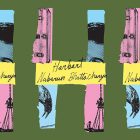Fear and Selfishness in The Dangers of Smoking in Bed

“In an individual, selfishness uglifies the soul; for the human species, selfishness is extinction,” wrote David Mitchell in his 2004 science fiction epic Cloud Atlas. Unchecked selfishness, Mitchell warned, would be society’s downfall.
I’ve been thinking a lot about selfishness in the eleven months I’ve spent in lockdown: the selfishness of my fellow citizens hoarding food and supplies, insisting on gathering in large groups, refusing to wear masks. I don’t believe that people choosing to behave this way was inevitable, but in the absence of national guidance on how to act, we have all been left to decide for ourselves how to survive. As COVID-19 spread, a shadow pandemic of self-interest has overtaken the country, Gal Gadot’s “We’re all in this together” Hollywood optimism quickly usurped by the brutal reality of “Every man for himself.”
Is this pervasive selfishness a nasty byproduct of American individualism? Are my countrymen just a bunch of jerks? I think not—rather, people are really, really scared. And I think there’s a link between fear and selfishness, a connective thread that, for some people, triggers an instinct to barricade rather than welcome, to preserve the self by sacrificing others. I recall Kathy Bates as Molly Brown in Titanic, looking with disbelief at the other passengers in her lifeboat as they refuse to turn the boat around to rescue other survivors. “I don’t understand a one of ya,” she says, and is answered only by the silence and averted eyes of people terrified into solipsism.
In The Dangers of Smoking in Bed, the newly translated by Megan McDowell 2009 short story collection by Argentinian writer Mariana Enriquez, people are afraid: afraid of poverty, afraid of solitude, afraid of confronting the grotesqueness of their own mistakes. One of the strings binding the collection is that again and again fear pushes the characters into committing craven acts of selfishness.
Enriquez’s stories are dark and macabre, and she deploys ghosts and other supernatural elements with a directness earned by her years as a journalist covering life after Argentina’s Dirty War. In the 2017 English translation, also by McDowell, of her 2016 short story collection Things We Lost in the Fire, Enriquez confronted the haunted legacy of her home country. She brings that same eerie sensibility to this latest collection, but makes it more intimate and personal, showing the many perverse shapes fears can take, and how people contort and break under the weight of those fears.
In “The Well,” Josefina has suffered paralyzing fear since she was a child, her fantasies ranging from the physical to the spectral. If her mother is late coming home, for example, Josefina vomits, certain she’s died in a car crash. And “she never slept with a leg uncovered, because she just knew she would feel a cold hand touching it.” Unable to attend school, sleep, or leave the house, her terror is so consuming that, when her sister Mariela offers to take her out to the country to visit a witch who might be able to offer a cure, Josefina has to drug herself with sleeping pills to make the trip. When they reach the witch’s house, however, the witch greets them with remorse, telling the sisters that not only is Josefina’s case incurable, but that the source of her fear resides within her own family. Josefina is left bearing the realization that the greatest horror in her life is not the dread that plagues her imagination, but the very real way her family has sacrificed her for their benefit. The story pivots upon this reveal of parental selfishness, leading both Josefina and the reader to understand that fear can trump familial obligation, that it can cancel our duty to others. This revelation is far more chilling than a spectral hand touching our leg in the dark.
Parental selfishness is again a theme in “Kids Who Come Back.” This story follows Mechi, who maintains files in an archive of lost and disappeared children in Buenos Aires. Mechi becomes fixated on Vanadis, a teenaged runaway whose family refused to take her back when she was arrested for prostitution, and who had made no effort to find her in the year she’d been missing. When Vanadis and dozens of other lost children begin reappearing en masse, materializing in public parks around the city, Mechi’s joy at their appearance soon turns to horror. The children look the same as they did when they disappeared—in fact, they are all wearing the same clothes they’d had on when they were last seen. But no matter how much time has passed they have not aged, they seldom talk, they cannot account for where they have been, they do not eat, and their parents begin to return the children to the parks where they appeared, claiming that they are not their real children, that they are only shells.
As their families and the public come to fear and reject the children, one gets the sense they are revolted not so much by the children’s seeming emptiness as by their own complicity in their disappearance. Unable to confront the true horror of a society that permits missing and exploited children, the people around Mechi grow hostile and, rather than fix a broken world where children are abused and murdered, instead demand that the children leave. Enriquez does not soften her grip at this point, as might be expected. Driven behind the brick walls of an abandoned house, the children promise they will not stay hidden forever. “In summer we’ll come down,” they say as one, ensuring that no one in Buenos Aires will ignore their existence again. Enriquez excoriates not only the families and the institutions that failed these children, but also the fear with which the public greets their return. By selfishly demanding that the children stay out of sight, the public caters to the fear that threatens their status quo. Again, the true horror is not the empty children, but rather human nature.
There is a strong moral architecture in Enriquez’s stories, and she does not excuse her characters’ bad behavior, no matter how fearful or disenfranchised they are. Society again looks the other way when confronted with human suffering in “The Cart.” An entire neighborhood watches in silence as a drunken homeless man defecates on a sidewalk and is then beaten and chased away by another drunk. Soon, other bad things start happening in the neighborhood: a taxi driver’s car is stolen; a bricklayer falls to his death. After a few months of escalating misfortune, everyone in the neighborhood is destitute. “Coca ate her cat,” Enriquez writes, “and then she killed herself.” Despite their suffering, the neighbors learn nothing about compassion. Like the Titanic survivors pretending not to hear the screams of the people in the water, the neighbors lock their doors with chains and begin hoarding food. The homeless man had been pushing a cart loaded with bottles and old phone books, and after the beating he’d been forced to leave it behind. When all the bad luck runs through the neighborhood, someone sets the cart on fire, a desperate and pointless act as well as final proof in an argument Enriquez seems to be making about how fear drives people to their worst inclinations. Fear may make us selfish, one may imagine Enriquez saying, but that’s no excuse.
Enriquez’s gaze throughout the collection is unflinching, taking readers into dark and grotesque territory, yet it is her morality, a pervasive sense of right and wrong, that anchors each story and prevents the collection from veering into the lurid horror of tabloid tragedy. “I guess I’ve always been a dark child,” she told NPR in 2017. “There’s comfort in the darkness for me.” There is comfort in darkness because there is truth in darkness. It is this truth that upholds the moral universe of Enriquez’s stories and provides the reader a satisfaction denied her characters.
One of the most disturbing stories in the collection, and certainly the one whose imagery will stay with me longest, is “Where Are You, Dear Heart?” about a woman who is sexually aroused by the sound of heartbeats. While this story does not address fear or selfishness head-on, the two elements lurk in the shadows, watching. In her childhood, the unnamed narrator becomes fixated on Helen Burns, a minor character from Jane Eyre who dies early in the novel from tuberculosis. The narrator fanaticizes about Helen and Jane in bed together at the moment Helen dies, thinks how foolish Jane is to have slept through her friend’s death, and pretends her pillow is Helen dying before her eyes. “I watched her die, I held her hand, and she, who was expiring with her grey gaze fixed on my eyes as she fought for breath, allowed me to see something of that other place where she would spend eternity.” Contemplating horror is often how we process and control our fears. For the narrator, simple contemplation gives way to a more concrete desire for control as her sexual appetites become both irrepressible and more narrowly defined. The woman’s quest for sexual satisfaction escalates in what amounts to a master class on maintaining narrative tension. The story culminates in an act of selflessness that is as beautiful as it is shocking, leaving me to wonder: if fear breeds selfishness, is courage then, required for selflessness?
“Where Are You, Dear Heart?” is the closest any of Enriquez’s stories come to offering anything close to absolution. The others often close on a note of certainty while withholding moral satisfaction—she has shown us the grim topography of the world; what we choose to do with that information is up to us. It may not feel comforting to see the ugliness of our world manifest before us, but if selfishness means extinction, as David Mitchell warned, I’d rather see it coming.
This piece was originally published on February 4, 2021.



